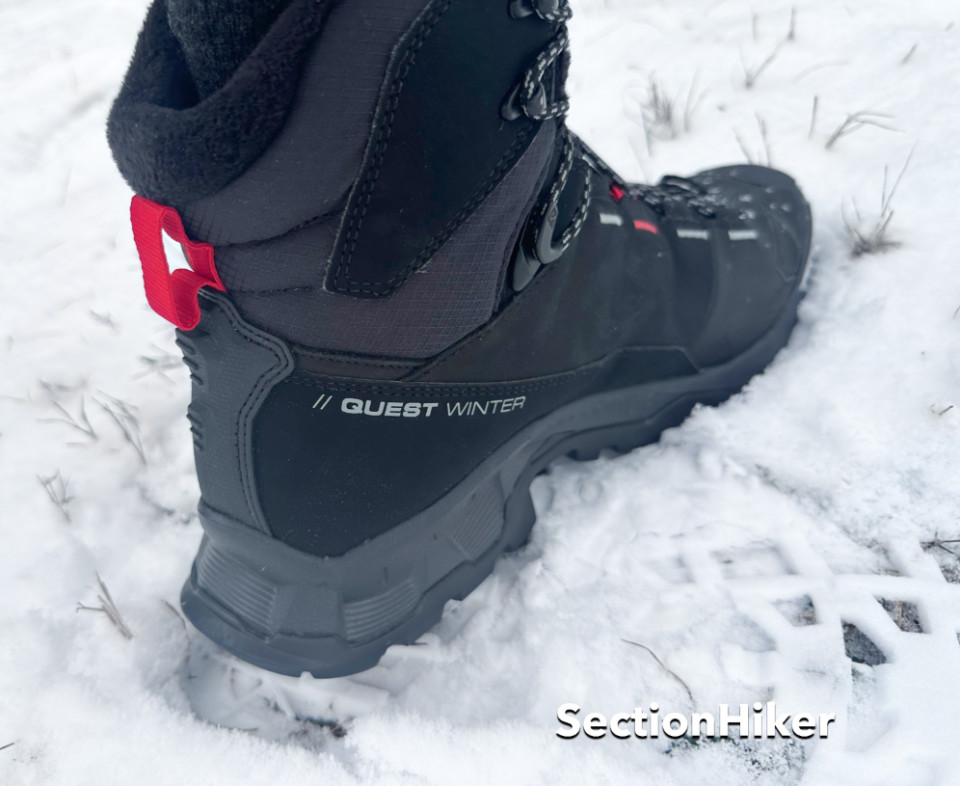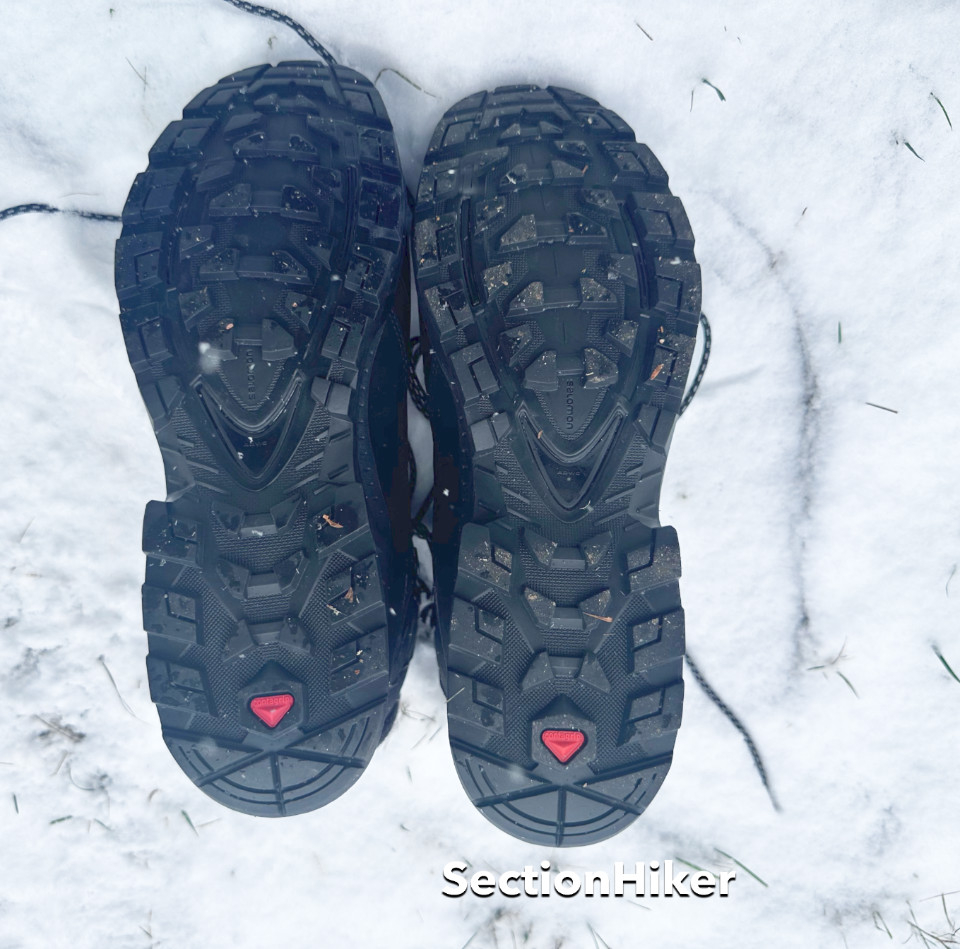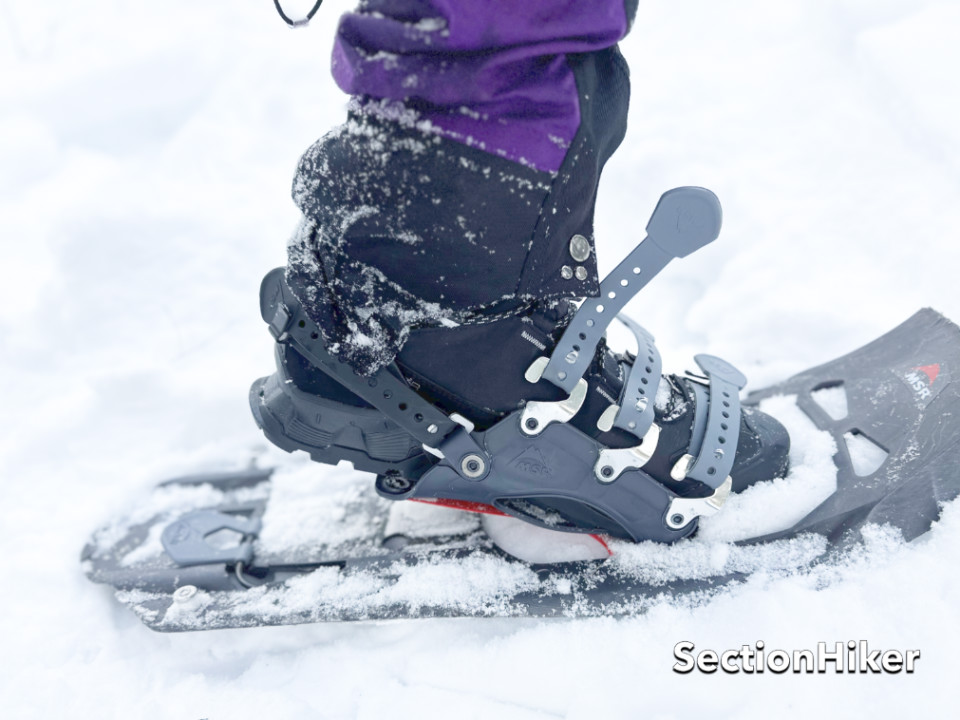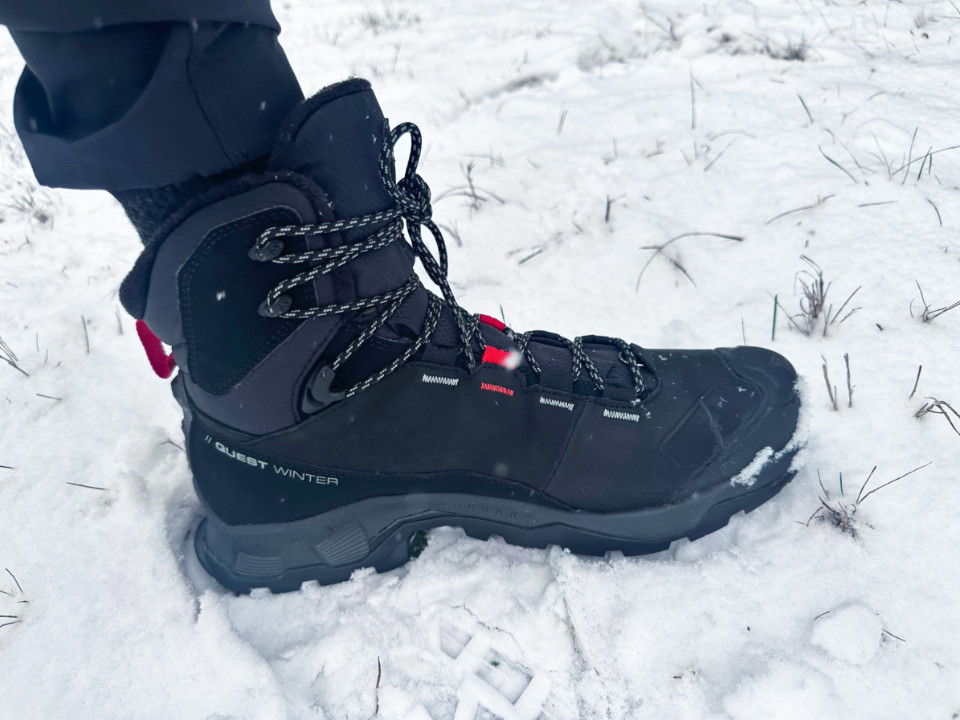Salomon’s Quest Winter Hiking Boots are insulated with 400g Thinsulate and have a very large toe box making them a good option for hikers who need more room for their toes or toe warmers which require some extra volume space for comfortable use. They have a well-protected toe kick which is an asset in winter with aggressive lugs and a slightly flared heel like many of Salmon’s trail running shoes. The soles are arched which makes them easier to use with gaiters, they have a front gaiter ring, and ridges on the back of the heel that prevent snowshoe straps from sliding off your boots. While they have 400g insulation, they’re sized like most “lower” 200g insulated boots making them a bit easier to walk in than the calf-high 400g boots sold by most other boot manufacturers.
Specs at a glance
- Gender: Unisex
- Insulation: 400g Thinsulate
- Temperature Rating: -20F (assuming active use, not standing around)
- Weight: 2 lbs 15.2 oz in size 11 men’s
- Waterproof: Yes
- Height: 8″
- Gaiter Hook: Yes
- Heel Ridges: Yes
- Sole: Contragrip
The Salomon Quest Winter Hiking Boot is a winter version of Salomon’s bestselling 3-season Quest Hiking boot. While it’s a chunky boot with a big and rigid toe box and excellent side protection, it’s nimble in comparison to the 400g boots offered by other winter hiking boot manufacturers, with a flared heel, arched insole, and soft rubber Contragrip lugs commonly found of Salomon trail runners and warm weather hiking boots.

The Quest Winter also has an oversized toe box in terms of width and height, which hikers preferring extra toe space will appreciate. The toe box is well-protected and made with rigid rubber which is useful in winter when kicking steps to gain traction on frozen uphills, when snowshoeing with pivot-style snowshoes, or when worn with microspikes because it resists collapsing under an elastomer harness.
Salomon Quest Winter Thinsulate ClimaSalomon Waterproof Boots
Foot Protecton
Traction
Sensitivity
Warmth
Water Resistence
Sizing
Weight
Durability
However, the Quest Winter is not as warm as most taller winter boots even though it’s insulated with 400g Thinsulate. This denotes the thickness of the insulation and not the weight of the actual insulation in the boot. For instance, Salomon rates the Quest Winter as being warm down to -10-20F, which is significantly less than the -40F temperature ratings offered by other brands. In my experience, they are colder boots than their other 400g counterparts, in part because they are lower and don’t provide as much lower leg, calf, and shin insulation.

That height difference also makes a big difference in how they feel when you hike in them. In the Quest Winter, your forward motion emanates from the ankle like a regular pair of 3-season hiking boots instead of the shin or calf, which is what you’d experience in a 10″ boot like the Oboz Bridger.
Another difference between the Quest Winter and other boots is that they have unisex sizing and don’t come in distinct men’s and women’s versions. Women run colder than men because on average, they have less body mass, so it’s a bit disingenuous for Salomon to expect or promote that both men and women will experience the same degree of warmth wearing these boots. If you’re female, I’d recommend buying a women’s specific boot instead.

While the Quest Winter Boots have soft Contragrip lugs, the boots themselves are quite rigid which is a plus for winter use. The uppers are a combination of leather and synthetic material and with a faux fur interior and ankle which is quite comfortable and warm.
Recommendation
Salomon’s Quest Winter Hiking Boots are a good 400g insulated boot although they’re not as warm as the taller, calf-high 400g boots sold by other manufacturers because they provide less lower leg and calf coverage. They have an oversized toe box which is good if you prefer more space or need the extra volume to insert toe warmers when you hike. If you regularly hike in three-season hiking boots or mids, they take very little time to adjust to in terms of your gait compared to much higher winter hiking boots. All in all, they’re a good option if you don’t need a winter hiking or mountaineering boot rated to -40F or you like the Contragrip sole and lugs used by Salomon throughout their product line.
| Shop at REI | Shop at Amazon |
SectionHiker is reader-supported. We only make money if you purchase a product through our affiliate links. Help us continue to test and write unsponsored and independent gear reviews, beginner FAQs, and free hiking guides.
 SectionHiker.com Backpacking Gear Reviews and FAQs
SectionHiker.com Backpacking Gear Reviews and FAQs 
-20F active use? So basically my Lowa’s with heavy wool socks?
Except your lowa’s are probably only good to about 10 degress with heavy wool socks and are not waterproof and will freeze if they get wet. There really is something to be said for waterproof boots in winter.
I’ll stick with my 200g Oboz Bridgers. I can’t stand the taller boots, they rub me wrong. I wear a mid weight injinji toe sock as a liner with a mid weight smart wool or darn tough over them. I attach toe warmers to the “ ceiling “ of my boots. This has worked well for me, & I tend to run cold.
I just took them today for a hike up the Pyrenees with Petzl leopard crampons and were nice and comfy. Similar to a 3 seasons hiking boot. About freezing, and active, no feeling neither cold neither too warm. I still have to run them in back at the achiles tendom though.
When I first got them last year I thought they were pretty warm, but after hiking in NH recently my toes were getting cold. I think they are warmer than my 200g Keens not as warm as my old Toundras. I do like the regular hiking boot feeling, they feel solid and nimble.
Definitely not as warm as other 400g boots, but I found them to be a nice upgrade from my previous 200g boots (Oboz) in terms of fit, durability, and waterproofing. The lower height works better for me in terms of comfort, so I’m willing to sacrifice a bit of warmth.